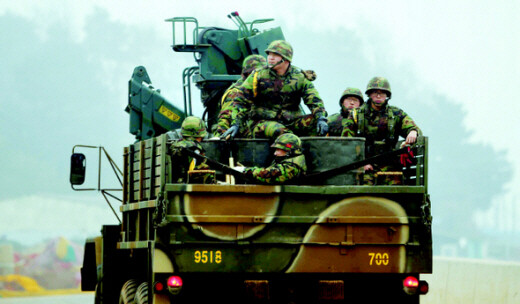hankyoreh
Links to other country sites 다른 나라 사이트 링크
S.Korea to resume artillery exercises on Yeonpyeong

By Lee Sei-young
Artillery exercises by a South Korean Marine unit stationed on Yeonpyeong Island are scheduled to resume shortly following their suspension in the wake of North Korea’s sudden artillery attack. The strong likelihood of additional attacks from North Korea, which has claimed the nearby waters to be its own in a long-standing territorial dispute, and the South Korean military’s declaration of “certain punishment” in the event of another provocation have sparked concerns about a return to hostilities between North Korea and South Korea.
A South Korean Joint Chiefs of Staff official said Wednesday, “The exercises will continue, and we will set a specific date that takes into account resident safety and weather conditions.”
While the South Korean military currently has plans to hold artillery exercises between Dec. 6 and 10 on Daecheong Island, one of the five West Sea islands, and in the West, South, and East Seas, some predict that exercises may resume on Yeonpyeong Island before the U.S. military aircraft carrier group leaves the waters of the Korean Peninsula following the conclusion of joint exercises with the South Korean military in the West Sea.
Many analysts are also interpreting the unexpected visit to the Marine Corps Command and other locations Wednesday by Chairman of the Joint Chiefs of Staff Han Min-goo as another sign that exercises are imminent. Han is reportedly more determined than anyone to resume Yeonpyeong Island artillery exercises as soon as possible.
Indeed, a number of military officials believe that artillery exercises should resume before the aftershocks of the North Korean attack subside. Their argument is that it will be difficult to recover from the wound to South Korean pride if the artillery exercises resume after the situation has settled down. Some in the military are also arguing the need to muster the reinforced artillery firepower at Yeonpyeong Island and aerial support to wage a clear-cut retaliatory attack in the event of additional provocations in order to recover their tarnished prestige.
However, some observers have expressed the concern that the situation may devolve into a type of staring contest.
“The military should be focusing on deterring provocations,” said a general in the reserves. “This attitude of accepting the possibility of clashes, talking about how the military will restore its honor, could actually make the situation more uncertain for South Koreans.”
Experts have also stated that North Korea will not risk international criticism with an additional provocation even if Yeonpyeong Island artillery exercises resume, as it already accomplished its political goal of “turning the West Sea into a disputed area” with its first attack.
Meanwhile, the joint South Korea-U.S. exercises in the West Sea came to a close at 2 p.m. Wednesday. The four-day exercises, which began on Nov. 28, included the newest in equipment from both countries, among them South Korea’s 7,600-ton AEGIS destroyer Sejong the Great and the 97,000-ton U.S. nuclear-powered aircraft carrier USS George Washington. Observers have questioned whether the exercises will meet the military authorities’ official stated goal of “ensuring a deterrent against North Korea.”
D&D Focus Editor-in-Chief Kim Jong-dae said, “There was no reason to use the term ‘show of force’ in explaining the exercises.”
“By limiting the character of these large-scale measures, which even included a nuclear-powered aircraft carrier, to that of a display, they basically just sent North Korea an invitation to watch a show,” Kim added.
Other observers have said that the use of equipment that North Korean cannot afford such as aircraft carriers, fighter-bombers, and AEGIS destroyers could backfire by making the country acutely aware of the limitations of competing with traditional weaponry and reaffirming its perceived need to beef up its asymmetrical warfare capabilities with nuclear weapons and missiles.
Analysts also predict that the large-scale exercises off the Chinese coast could heighten military tensions in Northeast Asia by provoking China in addition to North Korea.
Please direct questions or comments to [englishhani@hani.co.kr]
Editorial・opinion
![[Column] Park Geun-hye déjà vu in Yoon Suk-yeol [Column] Park Geun-hye déjà vu in Yoon Suk-yeol](https://flexible.img.hani.co.kr/flexible/normal/500/300/imgdb/original/2024/0424/651713945113788.jpg) [Column] Park Geun-hye déjà vu in Yoon Suk-yeol
[Column] Park Geun-hye déjà vu in Yoon Suk-yeol![[Editorial] New weight of N. Korea’s nuclear threats makes dialogue all the more urgent [Editorial] New weight of N. Korea’s nuclear threats makes dialogue all the more urgent](https://flexible.img.hani.co.kr/flexible/normal/500/300/imgdb/original/2024/0424/7317139454662664.jpg) [Editorial] New weight of N. Korea’s nuclear threats makes dialogue all the more urgent
[Editorial] New weight of N. Korea’s nuclear threats makes dialogue all the more urgent- [Guest essay] The real reason Korea’s new right wants to dub Rhee a founding father
- [Column] ‘Choson’: Is it time we start referring to N. Korea in its own terms?
- [Editorial] Japan’s rewriting of history with Korea has gone too far
- [Column] The president’s questionable capacity for dialogue
- [Column] Are chaebol firms just pizza pies for families to divvy up as they please?
- [Column] Has Korea, too, crossed the Rubicon on China?
- [Correspondent’s column] In Japan’s alliance with US, echoes of its past alliances with UK
- [Editorial] Does Yoon think the Korean public is wrong?
Most viewed articles
- 1‘We must say no’: Seoul defense chief on Korean, USFK involvement in hypothetical Taiwan crisis
- 2N. Korean delegation’s trip to Iran shows how Pyongyang is leveraging ties with Moscow
- 3‘Weddingflation’ breaks the bank for Korean couples-to-be
- 4Korea sees more deaths than births for 52nd consecutive month in February
- 5[Column] Park Geun-hye déjà vu in Yoon Suk-yeol
- 6Will NewJeans end up collateral damage in internal feud at K-pop juggernaut Hybe?
- 7[Column] Has Korea, too, crossed the Rubicon on China?
- 8Amnesty notes ‘erosion’ of freedom of expression in Korea in annual human rights report
- 9Samsung barricades office as unionized workers strike for better conditions
- 10[Column] The clock is ticking for Korea’s first lady